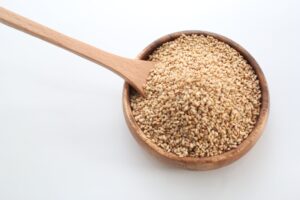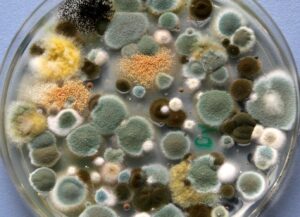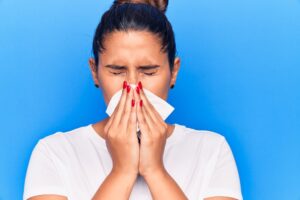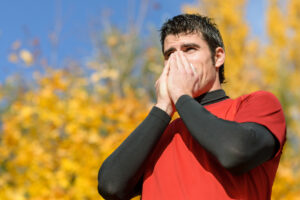Corn Allergy and Corn Intolerance
 Corn (i.e., maize) is a popular staple food worldwide, providing essential nutrients such as vitamins, minerals, and fiber. Corn is also a common component of processed foods. Despite its nutritional value and popularity, for those individuals with corn allergies or corn intolerance, consuming corn or corn-derived products may lead to adverse health effects.
Corn (i.e., maize) is a popular staple food worldwide, providing essential nutrients such as vitamins, minerals, and fiber. Corn is also a common component of processed foods. Despite its nutritional value and popularity, for those individuals with corn allergies or corn intolerance, consuming corn or corn-derived products may lead to adverse health effects.
Although corn allergies and intolerance are relatively uncommon compared to other food allergies and intolerances, they can still cause significant discomfort and health issues for affected individuals.
Corn allergies are caused by an overreaction of the immune system to proteins found in corn whereas corn intolerance typically results from the body’s inability to digest or process corn.
Corn Allergy:
There may be a genetic predisposition to developing a corn allergy, as it is more common in individuals with a family history of allergies or other allergic conditions, such as asthma or eczema (i.e., atopic dermatitis). Corn allergy is not a very common food allergy. The prevalence of corn allergy is approximately 2% in whites, 7% in Hispanics, and 15% in African Americans. Corn allergy occurs when the immune system mistakenly identifies corn proteins as harmful substances. As a result, an allergic reaction ensues against the corn protein. In this allergic reaction, the body produces immunoglobulin E (IgE) antibodies which trigger the release of chemical mediators such as histamine, leukotrienes, prostaglandins, as well as other inflammatory chemicals. In doing so as a mechanism to “kill” or “get rid of” the allergen (e.g., corn protein), the individual experiences classic allergy symptoms such as itching (i.e., pruritus), hives (i.e., urticaria), swelling (i.e., angioedema), gastrointestinal symptoms, wheezing, shortness of breath, or anaphylaxis.
Zein is the major storage protein found in corn. It makes up about 45% of the protein in corn. Zein is used as a coating for nuts, pills, candy, fruit, as well as other encapsulated foods and medications. In addition to zein, lipid transfer protein and profilin are two other proteins that are found in corn. These 2 proteins are primarily responsible for most of the corn allergy that occurs. Allergies to the heat-stable lipid transfer protein in corn may cause severe allergic reactions whereas an allergy to the heat-sensitive profilin protein usually only cause mild to moderate reactions.
Symptoms:
Mild to moderate corn allergy symptoms may include sneezing, itchy mouth, itchy throat, runny nose, nasal congestion, post-nasal drip, generalized itching, hives, and/or gastrointestinal issues such as nausea, vomiting, and/or diarrhea.
In rare instances, corn allergy may lead to anaphylaxis, a severe and potentially life-threatening allergic reaction. The symptoms of anaphylaxis may include hives, swelling of the throat or tongue, wheezing, shortness of breath, rapid or weak pulse, and/or a sudden drop in blood pressure.
Diagnosis:
The diagnosis of corn allergy requires a thorough history of the timeline of consumption of the corn-containing food(s) and the symptoms experienced. The diagnosis can be confirmed by identification of corn specific IgE antibodies either by skin prick testing or by blood testing. The gold standard for establishing the diagnosis of corn or any other food allergy however is an oral food challenge.
Corn allergy may be associated with cross-reactivity to other food allergens such as certain grains, legumes, and seeds. A high degree of cross-reactivity has been demonstrated among the lipid transfer proteins of corn (maize), peach, apple, apricot, walnut, hazelnut, peanut, rice, sunflower seeds, and French beans. This cross-reactivity means that individuals with a corn allergy may also experience allergic reactions to other foods containing similar proteins.
Occupational exposure to maize, maize dust, or maize flour may result in occupational asthma or rhinitis, in particular in mill workers, bakery workers, and those working in the animal feed industry. Allergic reactions have also been reported to cornstarch powder when used as a glove lubricant. Symptoms include hives, swelling episodes, sneezing, runny nose, nasal congestion, post-nasal drip, itchy eyes, watery eyes, redness of the eyes, asthma, and/or intermittent episodes of shortness of breath.
Corn has been implicated as one of the foods that can cause eosinophilic esophagitis, a disorder with symptoms suggestive of gastroesophageal reflux disease (GERD) but unresponsive to conventional anti-reflux therapies.
Treatment:
The treatment of corn allergy usually includes the use of antihistamines. Antihistamines can relieve the mild symptoms of allergic reactions such as itching and rashes. Severe reactions such as anaphylaxis usually require epinephrine injections either with a syringe and a needle or with a self-injectable epinephrine device (e.g., EpiPen, Auvi-Q, Adrenaclick). It should be noted that if an individual uses a self-injectable epinephrine device, they must go immediately to the closest emergency room.
Prevention:
The avoidance of foods containing corn products is the only definitive preventive measure. It is essential to read food labels carefully, as corn-derived ingredients can be found in various foods under different names, such as cornstarch, corn syrup, dextrin, and maltodextrin. It is essential to be vigilant about identifying hidden sources of corn and choosing alternative products when necessary. Corn may be present in salad dressings, sauces, processed meats, and in certain medications and supplements.
Corn Intolerance:
Certain enzymes such as amylase are necessary to break down complex carbohydrates into simple digestible sugars. The deficiency of these enzymes can result in bothersome gastrointestinal symptoms such as abdominal bloating, cramping, abdominal pain, and diarrhea after consuming corn products.
Sensitivity to specific corn components, such as cornstarch or corn syrup, may also contribute to corn intolerance. Though less common, intolerance can also result in skin manifestations such as rashes and itching, as well as respiratory symptoms such as cough, chest tightness, wheezing, and/or shortness of breath.
Corn is a low FODMAP food. FODMAP stands for fermentable oligosaccharides, disaccharides, monosaccharides and polyols. Foods high in FODMAPs may cause symptoms of food intolerance, thus affecting the gastrointestinal system. These symptoms of intolerance however can be mistaken for a true food allergy. Note that even though corn is a low FODMAP food, corn syrup, on the other hand is a high fructose food and thus considered a high FODMAP food.
Corn, like other grains, contains a moderate amount of lectins. Lectins are another cause of food intolerance. Cooking foods with lectins makes them more digestible and can reduce the symptoms of food intolerance however.
Corn allergy has been associated with a condition called “latex food syndrome.” The syndrome occurs when an individual who has a latex eats a food that has proteins in it that are similar to the proteins found in latex. The rubber tree plant Hevea brasiliensis which is involved in latex allergy, has an allergen called Hev b 11 which is a chitinase protein. Many plant and animal tissues contain chitinase proteins which are allergenic. Corn, kiwi, chestnut, mango, banana, avocado, pomegranate, and dates all contain chitinase proteins. Those that are sensitized to latex may have allergic reactions from foods containing similarly shaped proteins. Approximately 30% to 50% of individuals with latex allergies have a cross-reaction to foods with these proteins. The symptoms are primarily oral symptoms (e.g., itchy mouth, lips, tongue and throat) and are often referred to as oral allergy syndrome or pollen food allergy syndrome. Oral allergy syndrome mostly affects people who already suffer from pollen allergies and seasonal allergic rhinitis.
Prognosis:
Healthcare professionals, patients, and caregivers all play a vital role in the successful management of corn intolerance and allergies. Working together to identify triggers, develop individualized management plans, and provide ongoing support can help ensure that individuals with corn allergies or intolerance can live healthy and fulfilling lives.
If you suffer from a corn allergy or other food allergy or intolerance of any kind, the board certified allergists at Black & Kletz Allergy have the expertise in order to diagnose and manage this condition. We treat both pediatric and adult patients and have offices in Washington, DC, McLean, VA (Tysons Corner, VA), and Manassas, VA. We have on-site parking at each location and both the Washington, DC and McLean, VA offices are Metro accessible. Please either call us for an appointment or you may alternatively click Request an Appointment and we will respond within 24 hours by the next business day. The allergy specialists at Black & Kletz Allergy have been treating allergy, asthma, and immunology patients in the Washington, DC metropolitan area for more than 5 decades and we strive to provide state-of-the-art allergy care in a professional and amiable setting.

 Snoring is not an uncommon symptom in patients with
Snoring is not an uncommon symptom in patients with  The Eustachian tube is a small canal that connects the middle ear to the back of the nose and upper throat. It is normally closed but opens when we swallow, yawn, or chew.
The Eustachian tube is a small canal that connects the middle ear to the back of the nose and upper throat. It is normally closed but opens when we swallow, yawn, or chew. The term “chronic sinusitis” is defined as an inflammation of the sinus or sinuses lasting more than 12 weeks in duration. The inflammation can be of any etiology however it is implied and commonly agreed upon that infection is the primary cause of chronic sinusitis. In order to understand chronic sinusitis, it is important to know the anatomy of a sinus. A sinus is a cavity in any organ or tissue, but in reference to allergies, it is a cavity in the skull and often referred to a “paranasal sinuses.” There are 4 paired sinuses in the cranial bones. They are named for their location with regards to the head and face. The names of the sinuses include the frontal, ethmoid, sphenoid, and maxillary sinuses. The frontal sinuses are located in the forehead region above the eyes. The ethmoid sinuses are situated between the eyes on each side of the upper nose. The sphenoid sinuses are positioned behind the eyes and bridge of the nose and lie in the deeper areas of the cranium. The maxillary sinuses are located on either side of the nostrils in the cheekbone areas.
The term “chronic sinusitis” is defined as an inflammation of the sinus or sinuses lasting more than 12 weeks in duration. The inflammation can be of any etiology however it is implied and commonly agreed upon that infection is the primary cause of chronic sinusitis. In order to understand chronic sinusitis, it is important to know the anatomy of a sinus. A sinus is a cavity in any organ or tissue, but in reference to allergies, it is a cavity in the skull and often referred to a “paranasal sinuses.” There are 4 paired sinuses in the cranial bones. They are named for their location with regards to the head and face. The names of the sinuses include the frontal, ethmoid, sphenoid, and maxillary sinuses. The frontal sinuses are located in the forehead region above the eyes. The ethmoid sinuses are situated between the eyes on each side of the upper nose. The sphenoid sinuses are positioned behind the eyes and bridge of the nose and lie in the deeper areas of the cranium. The maxillary sinuses are located on either side of the nostrils in the cheekbone areas. Allergic reactions to sesame are increasing in incidence over the past several years. Sesame is the 9th most common food allergy among children and adults. Approximately 0.23% of the U.S population are allergic to sesame. Although 0.23% seems like a small number, the National Institute of Health’s (NIH) researchers estimate that 17% of food-allergic children have a sesame allergy.
Allergic reactions to sesame are increasing in incidence over the past several years. Sesame is the 9th most common food allergy among children and adults. Approximately 0.23% of the U.S population are allergic to sesame. Although 0.23% seems like a small number, the National Institute of Health’s (NIH) researchers estimate that 17% of food-allergic children have a sesame allergy. It is quite common for individuals to be allergic to mold, particularly in the
It is quite common for individuals to be allergic to mold, particularly in the  Nasal polyps (i.e., nasal polyposis) are soft, benign growths that develop from the lining of the sinuses and nasal cavity. Approximately 4-5% of the general population has nasal polyps. They look like glistening moist grapes and are typically in the shape of teardrops. These new growths result from chronic inflammation of the tissues inside the nasal and sinus cavities. When the nasal polyps grow large enough, they may obstruct the nasal passages which will block the flow of air through the nose. The mechanical obstruction may also block the passage of secretions from the sinuses into the nose which may result in the predisposition of individuals to develop recurrent or chronic sinus infections.
Nasal polyps (i.e., nasal polyposis) are soft, benign growths that develop from the lining of the sinuses and nasal cavity. Approximately 4-5% of the general population has nasal polyps. They look like glistening moist grapes and are typically in the shape of teardrops. These new growths result from chronic inflammation of the tissues inside the nasal and sinus cavities. When the nasal polyps grow large enough, they may obstruct the nasal passages which will block the flow of air through the nose. The mechanical obstruction may also block the passage of secretions from the sinuses into the nose which may result in the predisposition of individuals to develop recurrent or chronic sinus infections.